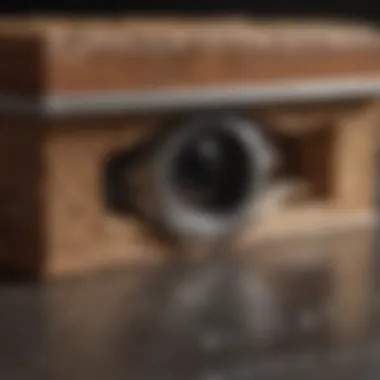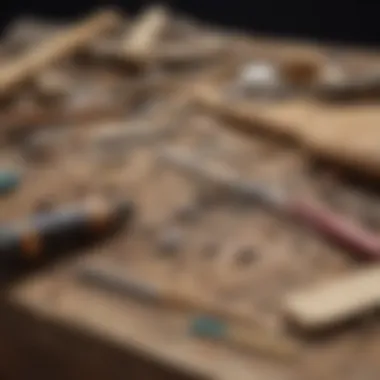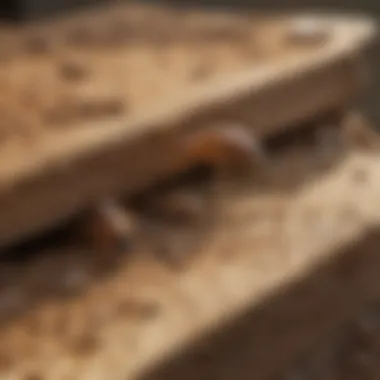Understanding Costs of Repairing Termite Damage


Intro
Termite damage is a significant issue for homeowners. The costs associated with repairing such damage can vary widely, influenced by several factors. Understanding the fundamentals of pest control, particularly in relation to termites, is essential. Knowledge in this area aids homeowners in making informed decisions, potentially mitigating repair costs before they escalate. This article explores the various aspects of termite damage repair, including costs, prevention, and alternative solutions.
Understanding Pests
Definition of Pests
Pests are organisms that harm crops, livestock, or humans. They can invade homes, causing structural damage, particularly termites. Termites consume wood, which can severely compromise the integrity of a structure. Identifying pests in their early stages significantly impacts repair costs and methods.
Importance of Pest Identification
Recognizing the type and extent of pest infestation is crucial. Different pests require different treatment approaches, which can influence both the nature of the repairs needed and the overall cost. Identifying pests accurately helps in choosing the right extermination strategies, ultimately affecting long-term expenses.
"Understanding the specific type of pest is the first step in creating an effective management strategy."
Prevention Techniques
Home and Garden Preventative Measures
Preventing termite infestations is more cost-effective than dealing with damage after it occurs. Effective measures include:
- Regular inspections of wooden structures and furniture.
- Removing wood debris from around the foundation of the home.
- Maintaining proper drainage to avoid moisture accumulation near foundations.
These steps help create an environment that is less inviting for termites.
Seasonal Prevention Tips
Termite activity can vary with the seasons. Being proactive during warmer months can yield significant rewards. Homeowners should:
- Inspect for mud tubes during spring and summer.
- Apply preventive treatments before rainy seasons.
- Trim shrubs and vegetation to maintain a barrier against pests.
These actions contribute to a long-term defense against infestations.
Eco-Friendly Pest Control Solutions
Overview of Sustainable Practices
Eco-friendly solutions are increasingly popular. They focus on minimizing chemical use while effectively managing pest control. Techniques such as integrated pest management blend various methods, including biological controls, habitat manipulation, and the use of natural barriers.
Natural Remedies and Their Effectiveness
Natural remedies can offer a less invasive approach to pest control. Some potential options include:
- Diatomaceous earth, which can deter termites when applied around the perimeter of a home.
- Orange oil, which has shown efficacy against termites when applied directly to infestations.
While natural remedies may not always work as effectively as chemical treatments, they offer a sustainable option for many homeowners.
Understanding the costs associated with termite damage repair involves recognizing the importance of pest identification, prevention techniques, and considering eco-friendly methods. Homeowners equipped with this knowledge are better positioned to manage termite risks effectively, safeguarding their homes and finances.
Prelude
Understanding the costs associated with repairing termite damage is crucial for homeowners. Termites can be silent destroyers, often causing extensive damage before the signs become evident. The financial implications can be significant, and ignoring these pests can lead to larger, more costly repairs in the future.
In this article, we will explore various elements of termite damage repair costs. We will discuss the importance of assessing the extent and severity of damage, choosing appropriate repair materials, and the labor involved in the repair process. Additionally, we will touch on how geographical location can affect pricing.
For homeowners, being informed about these factors is beneficial. It allows for better planning and budgeting, ensuring that one can adequately address any issues before they escalate. Developing a thorough understanding of the costs linked with termite repairs can position homeowners to make informed decisions, potentially saving them substantial amounts of money in the long run.
"Preventative measures and early detection can significantly reduce the financial burden of termite damage repair".
Whether you suspect an infestation or know you have one, knowledge about repair costs will guide you through managing this significant concern.
Through this article, we aim to equip homeowners with insights that extend beyond just costs. By emphasizing preventative strategies and regular maintenance, we contribute to more effective homeownership. Engaging in these discussions helps in ensuring the longevity and safety of one’s living environment.


Understanding Termite Damage
Understanding termite damage is crucial for homeowners. It helps to identify the early signs of infestation, which can prevent extensive structural issues. Termites, often referred to as silent destroyers, can compromise the integrity of a home before detection. Awareness of this issue not only protects the investment in a home but also improves safety for the inhabitants.
In this section, we will delve into several critical elements of termite damage. We will explore the biology of termites to understand how they function. We will also discuss the common signs of infestation every homeowner should look for. Additionally, we will review the types of damage termites can cause, emphasizing why early detection is important.
The Biology of Termites
Termites are social insects belonging to the order Isoptera. They thrive in colonies that can number in the thousands. Their diet primarily consists of cellulose found in wood, leaves, and other plant materials. This appetite for cellulose contributes to their destructive potential.
Termites are divided into three castes: workers, soldiers, and reproductive members.
- Workers: They are the primary foragers and builders, responsible for feeding the colony.
- Soldiers: Their role is to protect the colony from threats.
- Reproducers: The queen and king mate to ensure colony growth.
Understanding the biology of termites helps homeowners grasp their behavior. For instance, they typically work silently and quickly at night, making early detection challenging.
Common Signs of Infestation
Identifying signs of termite infestation is key to preventing severe damage. Homeowners should be vigilant for the following markers:
- Mud Tubes: Thin, pencil-sized tubes along foundation walls.
- Wood Damage: Hollow-sounding wood or wood that crumbles easily.
- Frass: Termite droppings that resemble sawdust or coffee grounds.
- Wings: Dropped wings of swarmers may be found near windows or lights.
These signs may vary depending on the species of termites, such as subterranean or drywood termites. Therefore, knowing what to look for can help ensure timely intervention.
The Types of Damage Caused by Termites
Termites can cause significant damage if left unchecked. Here are the primary types of damage:
- Structural Damage: This includes damage to foundational beams, flooring, and wooden framing.
- Non-structural Damage: Things like furniture and cabinets can also be affected.
- Aesthetic Damage: Appearance issues might arise, such as hollowed-out walls that destroy the visual aspect of a home.
It is essential to realize that not all damage is visible. Much occurs within walls and under floors, making inspections necessary.
Assessing Termite Damage
Assessing termite damage is crucial for several reasons. First, identifying the extent of the damage helps homeowners understand the potential financial impact. The sooner you assess the situation, the better. Ignoring signs of termite activity can lead to more severe structural issues, resulting in higher repair costs. Additionally, this evaluation guides decisions about whether to pursue professional help or to undertake repair efforts yourself.
When you assess termite damage, you look at various factors. Each aspect provides insight into the overall health of your home and its long-term viability. Homeowners often feel overwhelmed when they first discover signs of termites. But a thorough assessment can provide clarity. It could also save you money.
Home Inspection Overview
A home inspection is the first step in evaluating termite damage. This involves a detailed examination of visible areas in your home, including walls, foundations, and basements. Professional inspectors often look for signs of infestation like mud tubes, hollowed wood, or shed wings. It is important to note that even minor signs can indicate a more extensive problem.
Home inspections can vary in terms of thoroughness. Some inspectors might focus only on visible areas, while others utilize tools like moisture meters or thermal imaging cameras. The comprehensive nature of the inspection will significantly influence the resultant cost of repairs.
Evaluating Extent of Damage
Once the inspection is complete, you need to evaluate how extensive the damage is. It can be classified into minor, moderate, or severe. Minor damage might only involve cosmetic issues, such as surface scratches. Moderate damage could affect structural integrity, requiring more involved repairs. Severe damage often poses significant risks to your home’s safety and typically necessitates urgent and costly interventions.
Understanding the extent helps gauge what repairs are necessary. This can inform not only immediate costs but also long-term implications for home value. Homeowners should also consider the possibility of recurring issues if the infestation is not eradicated effectively.
Hiring Professionals vs. DIY Inspection
One key decision in assessing termite damage is whether to hire professionals or conduct a DIY inspection. Professional services can provide a more detailed and accurate assessment but come at a significant cost. Experts have the experience to detect problems that a typical homeowner may miss. They also possess advanced tools for deeper inspections.
On the other hand, DIY inspections can save money but carry risks. Homeowners might overlook critical signs of damage or misjudge the severity of the infestation. A hybrid approach could be the best solution, where homeowners do initial checks themselves and then hire a professional if needed. This helps balance cost with thoroughness in the assessment.
"Thorough assessment of termite damage can drastically cut down on future repair costs and enhance home safety."
Ultimately, understanding how to assess termite damage provides peace of mind. It allows homeowners to make informed decisions, whether for immediate repairs or preventative measures for the future.
Cost Factors in Repairing Termite Damage
Understanding the costs associated with repairing termite damage is vital for homeowners facing this issue. The expenses can be substantial and vary widely based on several crucial factors. This section delves into those elements, elucidating their significance in the overall financial implications of restoring a damaged property. Recognizing these factors equips homeowners with valuable insights, allowing them to plan and budget more effectively for repairs while also considering measures to prevent future infestations.


Extent and Severity of Damage
The extent and severity of termite damage significantly influence the repair costs. When termites invade a property, they can cause damage ranging from minor aesthetic concerns to severe structural issues. The costs escalate with the depth of the infestation and the damage incurred. For instance, replacing a few weakened floor beams is far less expensive than addressing major structural failures or complete wood replacement.
Homeowners should engage in a thorough inspection to evaluate how much damage has occurred. Considerations include:
- Visible damage, such as sagging floors or damaged wood
- Hidden damage, which may require more invasive inspection techniques
- Time elapsed since infestation, as older damage may complicate repairs
Ascertaining the level of damage is essential. It determines the necessary interventions and their corresponding costs.
Types of Materials Required
The types of materials involved in repairs will also dictate the overall expense of fixing termite damage. Different materials have distinct costs and durability rates. For example, using pressure-treated wood offers extra protection against future infestations but incurs a higher initial expense than untreated lumber.
Common materials used in repairs include:
- Wood (treated and untreated)
- Plywood for replacements and reinforcements
- Concrete in cases where the main structure is compromised
- Insulation materials when repairing walls affected by termites
Additionally, when contemplating repairs, one must consider if other materials, such as chemicals for treatments or barriers, will be necessary. The right material selection not only impacts cost but also the longevity and effectiveness of the repairs, further influencing potential future expenses.
Labor Costs Considerations
Labor costs play an instrumental role in determining the overall price of termite damage repairs. The complexity of the job affects how many professionals are required and for how long they will be needed. Hiring skilled labor, such as carpenters or pest control specialists, comes with varying rates influenced by local demand and skill levels.
- Experience level of the contractors can lead to differences in cost
- Location and regional rates can influnce labor costs significantly
- Specialized work (like structural repairs) may require higher fees
Homeowners might choose between contracting professionals or attempting repairs themselves. Notably, DIY options can save money but may carry risks if the homeowner lacks the necessary skills. Also, any mistakes could lead to higher expenses in the future.
Regional Variability in Pricing
The geographical location of a property plays a significant role in the costs associated with repairing termite damage. Different regions can have vastly different pricing structures based on economic factors such as labor costs, material availability, and local market rates.
For instance, urban areas might have higher labor rates due to demand and living costs, while rural areas may offer lower prices for labor but could face challenges in material availability. Some points that impact regional pricing include:
- Local building codes and compliance requirements
- Availability of pest control services
- General economic conditions impacting labor rates
It is beneficial for homeowners to conduct research on local repair costs. This includes comparing quotes from various services and checking reviews to ensure quality work at a reasonable price. Understanding these regional nuances will aid homeowners in making informed financial decisions.
Common Repair Techniques
Repairing termite damage involves various strategies that suit the nature and extent of the damage identified during inspection. Understanding these techniques is essential, as they can greatly affect the overall cost and effectiveness of the repairs. In this section, we will discuss three primary methods: replacing damaged wood, implementing structural reinforcements, and utilizing preventative treatments. Each technique comes with its own considerations, benefits, and costs that should be carefully evaluated.
Replacing Damaged Wood
Replacing damaged wood is a direct approach to repair termite-infested areas. This technique entails assessing which wooden components require replacement due to significant deterioration. Often, these components include beams, joists, and other structural supports that bear weight.
This method is beneficial because it ensures that the structural integrity of the home is restored. However, one must consider the type of wood to use in replacements. Treated wood, for example, can resist future infestations better than untreated options. The costs associated with this technique can vary widely based on the type of wood selected and labor involved in the replacement process. Often, the average cost can range from a few hundred to several thousand dollars, depending strongly on the extent of the damage.
Structural Reinforcements
Using structural reinforcements is another critical repair technique, especially when significant support is compromised. Reinforcements can include adding additional brackets or beams that help stabilize a weakened structure. This approach not only repairs the damage but also prevents future issues by fortifying the affected area.
This technique is particularly useful when the damage is extensive but does not require a complete replacement of materials. It is often less expensive than full replacements, as it typically involves less material and labor. However, the effectiveness of this method relies heavily on proper installation and skilled workmanship. Consequently, homeowners should consider hiring experienced professionals to ensure the integrity of the repairs.
Preventative Treatments
In addition to direct repairs, preventative treatments are vital for long-term protection against termites. These can include chemical barriers, baiting systems, and regular maintenance inspections. This approach mitigates the risk of future infestations by addressing the underlying causes of termite attraction.
Chemical treatments are often applied to the perimeter of a home to deter termites from entering. Utilizing bait systems can help reduce current termite populations while providing continuous monitoring. The initial cost for these preventative measures can seem high, but they are far less costly than extensive repairs that result from neglecting potential issues.
"An ounce of prevention is worth a pound of cure. Investing in preventative measures now can save significant costs in future repairs."
In summary, understanding various repair techniques is crucial for homeowners facing termite damage. Each method's cost-effectiveness, efficiency, and longevity should be considered in the decision-making process.


Detailed Cost Assessment
Assessing the costs associated with repairing termite damage is a vital part of understanding the overall financial impact of an infestation. This section aims to dissect various factors influencing costs and provide clarity on what homeowners can expect to pay for repairs. Knowing how to evaluate these costs helps property owners make informed decisions and potentially save money in the long run. By understanding the specific elements, benefits, and considerations surrounding cost assessment, homeowners can take proactive steps to mitigate further damage and manage expenses efficiently.
Average Costs for Minor Repairs
Minor repairs typically involve addressing surface damage or small areas affected by termites. The costs for these repairs vary, largely depending on the materials used and the extent of the damage. On average, homeowners can expect to pay between $200 and $1,000 for minor repairs. Common tasks include replacing a few pieces of wood, repairing drywall, and patching small holes.
The following factors influence the costs for minor repairs:
- Materials: You may need new wood, adhesives, or sealants, which can affect the overall cost.
- Labor: Hiring a handyman or contractor adds to the expense.
- Location: Labor rates can differ significantly based on geographic location.
Understanding the scope of minor repairs aids homeowners in budgeting. Regular maintenance and prompt action can minimize future expenses.
Costs Associated with Major Repairs
Major repairs can be significantly more costly and may involve extensive structural damage. Homeowners facing such repairs can expect costs ranging from $1,000 to $10,000 or more. Common major repair activities include:
- Replacing large structural beams or joists.
- Comprehensive treatment of affected areas to prevent recurrence.
- Addressing damage to surrounding infrastructure, such as plumbing or electrical systems.
Considerations for major repair costs include:
- Severity of damage: More extensive damage directly correlates to higher costs.
- Type of construction: Older homes may require more specialized repairs, which can increase expenses.
- Access to areas needing repairs: Hard-to-reach places may warrant higher labor costs.
The financial implications of neglecting major repairs can lead to even larger issues down the line, making it imperative to act swiftly and effectively.
Long-term Financial Implications
Understanding the long-term financial implications of termite damage is crucial for homeowners.
- Value Depreciation: Properties with a history of termite damage might experience a decrease in market value, which can impact resale opportunities.
- Insurance Costs: Homeowners may face higher premiums if termite damage is documented. Conversely, some policies might not cover the costs if termites are found.
- Maintenance Costs: Over time, if repairs are not adequately made, ongoing maintenance costs can skyrocket.
- Preventative Measures Expenses: Investing in preventative measures, such as regular inspections and professional treatments, can mitigate larger costs in the future.
To sum up, understanding the financial landscape of repairing termite damage is fundamental. Homeowners should closely evaluate both immediate and long-term repair costs to make informed decisions that protect their investment.
Preventative Measures against Termites
Termites can cause significant damage to homes, leading to costly repairs and extensive renovations. Prevention is the best strategy. Adopting effective preventative measures can save homeowners from future headaches and expenses. Understanding these measures is crucial for safeguarding properties and ensuring long-term peace of mind.
Regular Inspections and Maintenance
Regular inspections should be a routine part of any homeowner's maintenance schedule. Inspections allow for early detection of termite activity and potential infestations. Homeowners should check for signs of termites, such as mud tubes, discarded wings, and hollow-sounding wood.
Consider hiring a professional pest control service for annual inspections. They possess the expertise to identify hidden damage and recommend necessary treatments. Regular maintenance also includes ensuring that gutters are clear and water drains away from the foundation, as moisture attracts termites.
Environmental Modifications
Making certain environmental modifications can decrease the likelihood of termite infestations. For instance, homeowners should manage moisture levels around the property. This can involve fixing leaks, ensuring proper irrigation, and improving drainage. Keeping wood and vegetation at least six inches from the foundation will create a barrier against termite access.
Furthermore, using rock mulch instead of wood mulch in landscaping can also deter termites. Maintaining a clean yard free of wood debris and dead trees reduces risks. Though these modifications require some effort, they can go a long way in preventing termite issues.
Use of Chemical Barriers
Applying chemical barriers is another effective method of termite prevention. Chemical treatments can be used to create a barrier around the property, protecting it from potential infestations. Termiticides, such as fipronil and imidacloprid, are commonly employed for this purpose.
These chemicals should be applied by professionals to ensure effectiveness and safety. Homeowners must also be aware of the longevity of these treatments, as they need reapplication over time. Understanding the specific needs of one's home and environment is essential when selecting a chemical treatment.
"Prevention is less expensive than dealing with extensive repairs after termite damage has occurred. Prioritize your property's health with regular maintenance and preventive strategies.”
In summary, by embracing preventative measures against termites, homeowners can mitigate risks and protect their investments. Regular inspections, environmental modifications, and appropriate chemical use are critical components in the fight against termites.
Epilogue
In summation, understanding the costs associated with repairing termite damage is crucial for homeowners. Termites can pose a significant financial risk, as the costs can escalate quickly if damage is not addressed promptly. Homeowners need to comprehend not just the immediate expenses of repairs, but also the long-term financial implications that come from delayed action or insufficient treatment strategies.
Key elements include recognizing the severity of damage and the type of materials required for repairs. For instance, minor damage might only involve replacing a few boards, while severe infestations might necessitate extensive structural repairs. This dichotomy illustrates why a comprehensive assessment of damage is essential before engaging in repairs.
Considerations also extend to preventive measures. Regular inspections, environmental modifications, and the application of chemical barriers can mitigate future risks, reducing overall costs in the long run. It pays to proactively manage the threat posed by termites rather than reactively dealing with consequences of infestations.
"An ounce of prevention is worth a pound of cure."
Thus, understanding repair costs forms the backbone of effective termite management. By equipping themselves with knowledge, homeowners can make informed decisions, ensuring their properties remain safe and secure. This article aims to guide readers through the complexities of termite damage repairs, ultimately ensuring they avoid unnecessary expenses and protect their investments.



